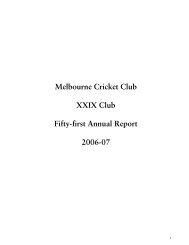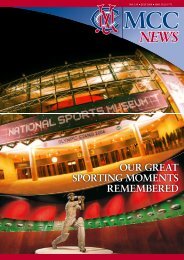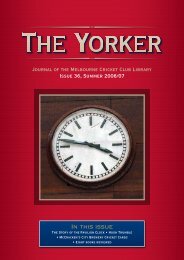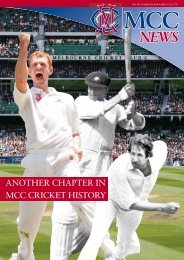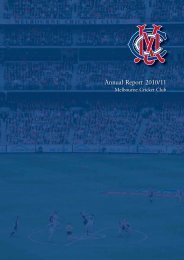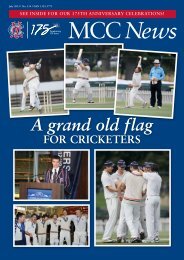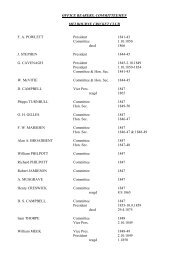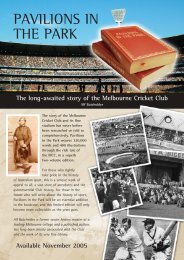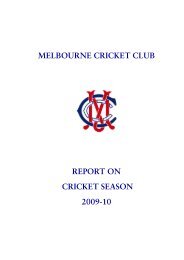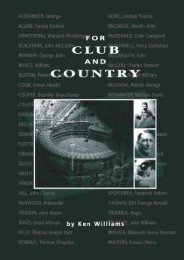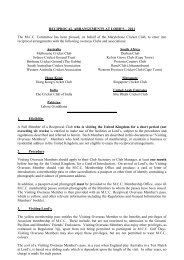Issue 42: Spring 2010 - Melbourne Cricket Club
Issue 42: Spring 2010 - Melbourne Cricket Club
Issue 42: Spring 2010 - Melbourne Cricket Club
You also want an ePaper? Increase the reach of your titles
YUMPU automatically turns print PDFs into web optimized ePapers that Google loves.
Roy Hay is an Honorary Fellow of Deakin University<br />
where he taught for 25 years. Roy is a partner in Sports<br />
and Editorial Services Australia and joint editor with<br />
Bill Murray of The World Game Downunder. He also has<br />
written histories of Deakin University, the Geelong<br />
Chamber of Commerce and St Joseph’s College, Geelong.<br />
He is a member and former president of the Australian<br />
Society for Sports History. He was football (soccer)<br />
writer for the Geelong Advertiser from 1991 to 2002 and<br />
since has had a regular (non-football) column there. He<br />
contributes to Goal Weekly and other football papers.<br />
His interest in early football in Victoria and Geelong in<br />
particular has led him to re-examine some assumptions<br />
other historians have made on the subject. His most<br />
recent publication is A tale of two footballs:the origins of<br />
Australian Football and Association Football revisited (Sport<br />
in Society, Vol. 13, No. 6. August <strong>2010</strong>, pp. 952–969).<br />
Geelong football<br />
Cec Mullen, Tom Wills and the search<br />
for early Geelong football<br />
By Roy Hay<br />
In 2008 Gillian Hibbins suggested to the editor of a new history of<br />
the Geelong Football <strong>Club</strong> that I might be approached to write the<br />
first chapter on the origins of the game in the area. It was a task I<br />
took on with some concern, since the bulk of my research had been<br />
on the history of Association football rather than Australian Rules.<br />
However, my interest in the emergence of the modern codes of<br />
football in the United Kingdom and around the world led me to<br />
accept the challenge and the result is now in print in a chapter<br />
titled “A <strong>Club</strong> is Born” of the book We are Geelong: The Story of the<br />
Geelong Football <strong>Club</strong>. 1 A fully referenced version of that chapter<br />
is available for anyone who wants to follow my tracks as I tried to<br />
tease out what happened in the middle of the 19th Century. 2<br />
Needless to say there are many parts of the story which remain<br />
unclear, including the precise role of a number of the key persons<br />
who contributed to the foundation and early development of the<br />
Geelong club, not least Tom Wills. It might help those who want to<br />
try to take the research further if I outline what I understand to be<br />
the state of play regarding one of the sources which still has an<br />
influence on the existing early history of the game.<br />
There is nothing more frustrating than chasing down historical<br />
references which turn out to be non-existent or inaccurate.<br />
Cec Mullen has given me more grief in relation to the Geelong<br />
Football <strong>Club</strong> and early football in the area than any other author. 3<br />
Mullen was a journalist and amateur historian, involved in a range<br />
of sports and youth activities in <strong>Melbourne</strong>.<br />
Most recent historians have ceased entirely to rely on Mullen and<br />
have effectively written him out of their work. 4 Geoffrey Blainey<br />
was one of the first to query Mullen’s work, 5 and MCC assistant<br />
librarian Trevor Ruddell mounted a gentle but devastating critique<br />
at an Australian Society for Sports History meeting 6 . Mullen is<br />
not cited in the authoritative history of the game by Rob Hess<br />
and colleagues, and Gillian Hibbins makes no reliance on Mullen<br />
in her studies of the early game. 7 When I sent Trevor Ruddell a<br />
copy of my draft for critical comment, he advised removing all<br />
references to Mullen from it. Robin Grow admits to selective use<br />
of Mullen, though I suspect never without checking thoroughly.<br />
However, Russell Stephens, whose Road to Kardinia was the<br />
standard work on the history of the Geelong Football <strong>Club</strong>,<br />
apparently relies on Mullen for several pieces of information<br />
including at least two lists of the names of clubs which are<br />
claimed to have existed in the area in the 1850s and 1870s. 8<br />
In 2009, after his death, Russell Stephens’ family published Wills<br />
Way, which was subtitled: Three Generations of the Wills Family and a<br />
New Game – Australian Football. 9 This is a beautifully produced work<br />
aimed at non-academic readers and as the author disarmingly admits<br />
contains much of his own imaginings of what Wills and his family were<br />
feeling, thinking and doing when the historical evidence is silent.<br />
From internal evidence it appears clear that Stephens continued<br />
to rely on Mullen, though since there are no references in this<br />
latest work it is not always possible to be certain. The contrast with<br />
Gillian Hibbins’ evocative reconstruction of the memoirs of William<br />
Hammersley, where her truth resides in the footnotes, is total. 10<br />
Since I have been insistent on finding evidence to support claims<br />
made about Aboriginal influence on the origins of football, I<br />
can do no less than demand the same for any other proposed<br />
source of material. So I have almost spent more hours trying<br />
to track down and confirm or deny Mullen’s claims than I have<br />
researching other aspects of the early game. So far this has<br />
proved an entirely negative exercise.<br />
In Mullen’s History of Australian Rules Football: 1858 to 1958, he says:<br />
“The Corio <strong>Cricket</strong> <strong>Club</strong> was playing in 1857–58 in East Geelong<br />
near the Botanical Gardens in what is now known as Eastern Park<br />
and we read in ‘THE GEELONG ADVERTISER’ in August, 1858, that<br />
at the meeting of the <strong>Cricket</strong> <strong>Club</strong> it would probably become the<br />
Geelong <strong>Cricket</strong> and Football <strong>Club</strong> and would keep its players in<br />
The Yorker - <strong>Spring</strong> <strong>2010</strong><br />
3



